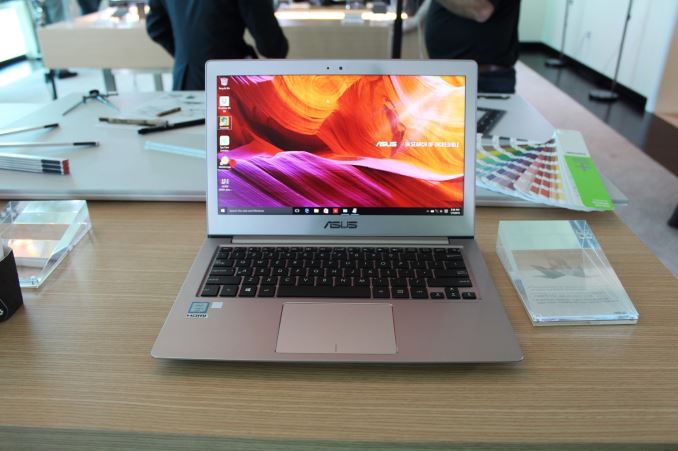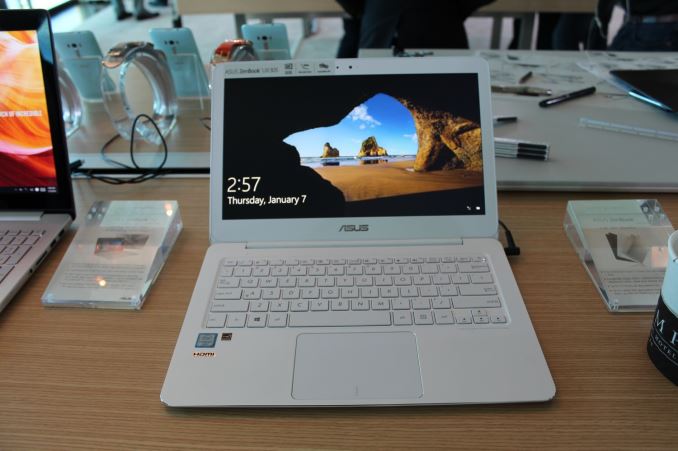ASUS Booth Tour at CES 2016: 10G Switches, External GPU Dock, USB-C Monitor and more
by Ian Cutress on January 19, 2016 9:00 AM ESTLaptops Laptops Laptops Laptops
Section by Brett Howse
ASUS didn’t have any really new laptops for CES, but we did get a chance to check out some that had been announced over the last couple of months with the launch of Skylake. The 15.6-inch ZenBook Pro is arguably ASUS’s flagship laptop, with a full aluminum chassis and 45-Watt Skylake CPUs. It also features an NVIDIA GTX 960M GPU, and PCIe storage. Optionally there is a UHD display with 100% Adobe RGB color space coverage. It’s a great looking laptop, and plenty powerful as well.
Moving down in price and performance is the UX303UA, which is a 13.3-inch Ultrabook with U series Skylake processors. It’s fairly light and thin, and is an incremental upgrade over the previous model. ASUS also had the UX305CA, which is the Skylake powered version of the UX305 that we reviewed in 2015, and ASUS sent us the new Skylake model to put through its paces so look for a review of this soon. The UX305 was one of our recommended Ultrabooks of 2015, as it offers more bang-for-buck at 8 GB of memory and 256 GB of SSD storage for just $699.
UX303UA
UX305CA
On the ROG side of things, I (Ian) saw the ROG GX700 laptop with the external water cooling graphics dock for the first time. Actually seeing the device (and how heavy it is), I finally understood the concept which didn’t come across that obvious before. The unit is a fully sealed graphics card and water loop, almost like a dock, which attaches firmly in place to the laptop and can’t be removed in use. When connected, it uses PCIe to interface between the CPU and GPU, much like other solutions such as the GS30.
What was perfectly clear is that this arrangement doesn’t come cheap. The laptop itself is a hefty number as well, making it less mobile than expected.














50 Comments
View All Comments
DanNeely - Tuesday, January 19, 2016 - link
Is the back of that phone actually made up of a bunch of triangular panels at angles to each other; or does the finish just fake the look?WorldWithoutMadness - Tuesday, January 19, 2016 - link
It is 3D (source http://www.androidcentral.com/hands-asus-zenfone-2...Panzerknacker - Tuesday, January 19, 2016 - link
I just dont understand why did 10G never become mainstream and is it so damn expensive? Back when 100mbit was mainstream the price of 1G was higher but nowhere near $760 for a switch. 1g is now mainstream for a decade or so, what takes it so long? Did we reach the limit of copper networking? I mean, in datacenters there has to be a enormous market for fast networking, I cannot understand why prices are still so high because on a huge market you would expect a lot a competition and fast development of hardware. Or did they completely move to different networking standards in datacenters, like fibre?Reflex - Tuesday, January 19, 2016 - link
Power consumption is very high compared to gigabit, and wireless replaced ethernet for most home and small office use, thus negating economies of scale which normally would drive prices down.Lieuchikaka - Thursday, June 2, 2016 - link
http://mavangvn.vn/ma-vang-dien-thoai/dien-thoai-s...TwistedKestrel - Tuesday, January 19, 2016 - link
It's mostly the ubiquity of 1GbE vs the handful of vendors making 10GbE parts. 1GbE PHYs are cheap as dirt, and 10GbE is two orders of magnitude more expensive... and there aren't that many people that want it yet. Once 1Gb+ throughput on 802.11ac radios becomes more commonplace instead of mostly theoretical, that would be something of a driver for consumer 10GbE.Interesting that a few US ISPs have upcoming or available service in excess of 1Gb, I wonder what kind of connections their equipment would have
DanNeely - Tuesday, January 19, 2016 - link
For consumer service, I'd be really surprised if it was anything but a combined modem/pretend it actually is able to achieve multi-gigabit speeds wifi router.iwod - Tuesday, January 19, 2016 - link
They have new standard NBase-T which provides 2.5Gbps and 5Gbps on Normal CAT 6 Cable. But no idea why no company are getting products out.Alex_M - Wednesday, January 20, 2016 - link
The real benefits for NBase-T will be 2.5/5 Gbps over exisitng Cat5e (not Cat6) upto 100m. It means we don't have to replace all those existing cable runs to benefit from the higher speed. Its fairly new but I hear that the silicon has started sampling....Lieuchikaka - Thursday, June 2, 2016 - link
http://mavangvn.vn/ma-vang-dien-thoai/dien-thoai-s...